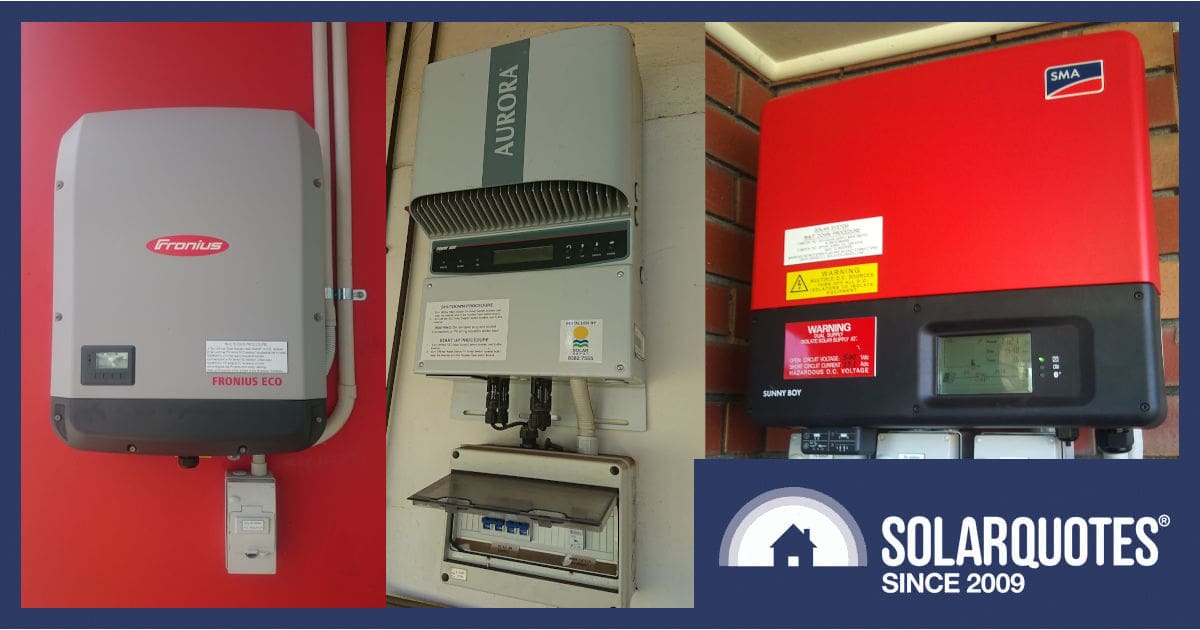
If you’ve had solar power for a few years and found your bills are getting uncomfortably high, you could probably use more solar yield. However, as we’ll explain, it’s not as simple as plonking more panels on the roof.
Older systems we’ve already covered. This discussion focuses on systems that may have been installed in the ‘teens.
Unfortunately, expanding middle-aged solar power systems can render a lot of good inverters and solar panels obsolete.
Professionally I’m disappointed, because it was hard graft putting this gear on the roof. And it’s infuriating because while second-hand solar panels might be redeployable, for worthy causes in developing nations, the world doesn’t need more e-waste made up of perfectly functional inverters.
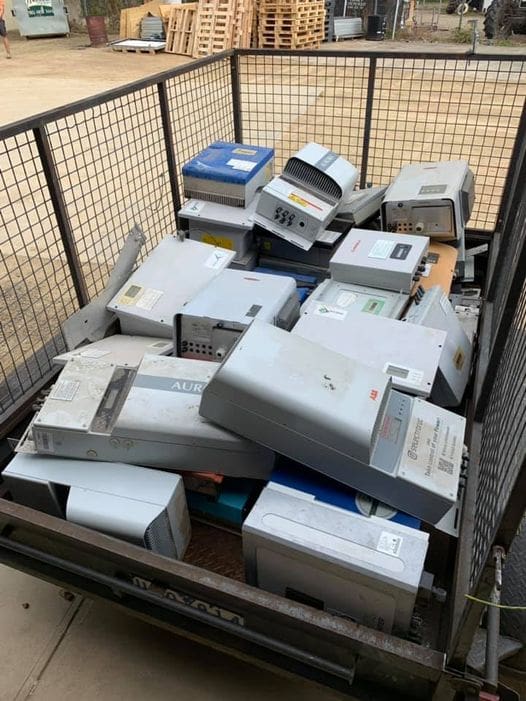
ABB/Aurora, Fronius IG were cut from a better cloth. Aerosharp were a knock off SMA but the rest of this bin is full of crap.
Practicalities Of Adding Panels
There are about as many scenarios as there are houses to install them on. Whether it’s microinverters, expanding an old system, a new inverter beside an old one, there can be lots to consider. We’ll follow up with more specific details in another article.
Points To Remember If Adding New Solar Panels to an existing system
- Most modern solar panels have crept up to 13 or 14amp output, so older inverters may clip or struggle for efficiency
- Mixing old panels and new inverters may void warranties
- Microinverters may have been sold as expandable, but mixing old models with newer series may not be feasible
- Expanded systems aren’t eligible for legacy premium feed-in tariff but the economic payback can still be attractive
Why You May Need To Junk Your Inverter
Considering the electricity distribution networks in Australia were designed for big steam engines as hubs with spokes of cascading losses, careful management is critical to keep the lights shining when, increasingly the thing is running in reverse. Managing thousands of little solar generators takes some smarts so we should be proud there’s Australians developing the technology.
The upshot? New solar must offer dynamic export control so networks can throttle output when conditions are too perfect. Sadly, most old solar inverters can’t be curtailed, so networks are insisting on new ones.
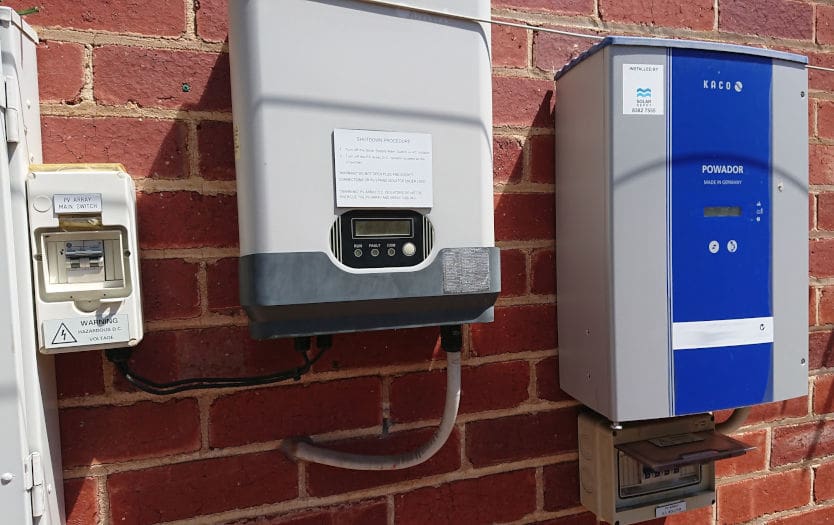
Kaco Powador, the “german quality” that evaporated alongside an Omnik. Standards are much improved since this junk was new.
So when you upgrade, your network will insist that you use an inverter that adheres to the absolute latest standards. It would be nice to have new systems working beside old ones, but there’s no grandfather clause sadly1
The good news is that a new inverter + new solar panels are classed as a whole new system that attracts new STC incentives. So while the rebate falls 7% each year, panel prices are falling too. New glass on the roof is still basically free.
Why You Might Need To Junk Your Solar Panels
If you get a new inverter, a new serial number means you can claim new STC credits, so it’s probably best to install a completely new system with new compliance and a full suite of features, including warranty.
I have seen first hand the retrospective regret of installers and customers when they’ve found hidden problems while moving old solar panels. Be it cracks in the backsheet or broken hardware from obsolete framing, the heartache is real.
Consider Adding Monitoring First
If you’ve got a big bill and a budget to replace your solar, there are significant benefits to the latest technology. Knowledge is power, so consider a switchboard upgrade with monitoring like CatchControl even before you add solar.
Having proper data is brilliant for visualising consumption, tailoring your retail deal and knowing what size solar you’ll need. If you’re considering a battery, make sure you have surplus energy or a clever TOU tariff to charge it. As a consumption meter, the CatchControl becomes an integral part of your new system.
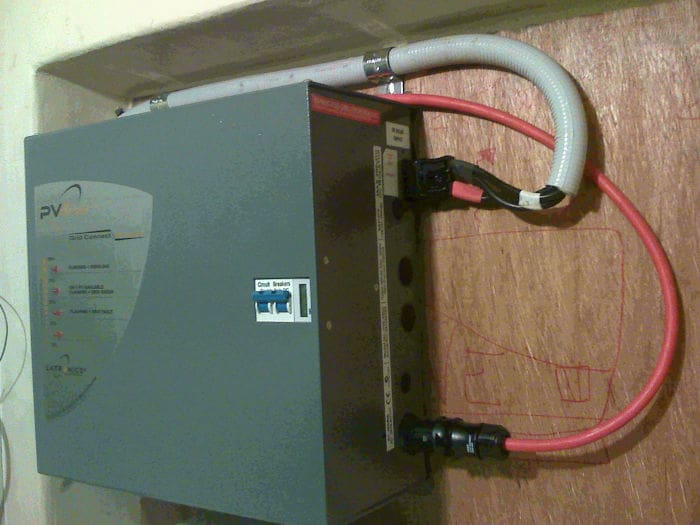
The award for brutalist design and minimalist styling goes to Latronics. Monitoring is nothing but four LEDs and a simple counter for kWh. This one still goes but I’m waiting for CatchPower to release a 3phase monitoring device.
Get Rid Of Roof Top Isolators
It’s seldom policed, but network rules mandate your solar power system should be inspected by an electrician every 5 years. Where it should be enforced is for the dreaded RTI. The opportunity to remove these fire prone DC switches is one I wouldn’t miss.
How To Legally Ignore Inverter Limits
If you want freedom from the rules and more capacity than the networks will allow, the solar inverter standard AS4777 now defines an inverter that’s an “independent” power supply separately from a conventional grid-tied inverter. A Selectronic SP-Pro inverter configured correctly means you can have a large independent system and treat the grid with contempt.
The SP Pro forms a gateway where, although you can’t export, the grid instead becomes your cheap, reliable backup generator.2 Then you’re free to have almost unlimited solar and battery downstream of it.
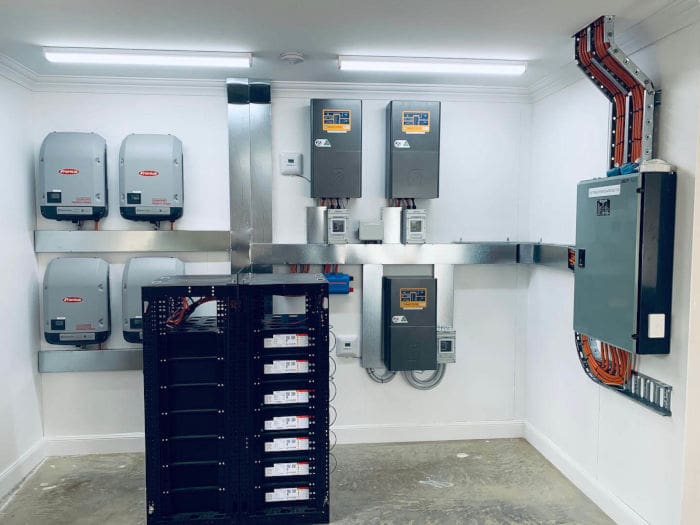
This customer wanted 40kW of solar on a single phase connection. Selectronic means he can thumb his nose at his local network inverter limits.
There’s No Time Like The Present
If you have the itch to do more with solar, click here to see what rules apply. With models designed for whole home backup, hybrid technology is genuinely powerful now, so it pays to get sound advice. Gather up your recent bills, download your utility meter data; then get an expert to visit your place and assess the place from the roof down. Click here to get scratching.
Footnotes
- If you have a Fronius SnapInverter, a simple firmware update offers standards compliance. Add a Fronius Gen24 with more solar and viola! the job is done. Your ten year warranty remains intact. ↩
- Generators are both unreliable and essential for long winter weeks; plus expensive to buy and maintain. As we say in the off grid industry, generators make the phone ring ↩

 RSS - Posts
RSS - Posts



Putting more panels on the roof is simply throwing good money after bad.
I put in my first 2Kws of solar on the roof in August 2011. We were told we were not only saving a lot of money and protecting the future of the planet……. we could actually make money by being a power generator. We were given great enticements to become green citizens. At the time I was paying 19c per Kw/hr to buy power from the grid and I was getting 60c per Kw/hr to feed my excess solar back into the grid.
How many of you would like that deal hey?? Worst $3,500 I ever spent!!
The problem with solar is, ‘you have got it when you don’t need it’!
All along the way since 2011 I have been told I need to spend yet more money to take advantage of this solar revolution.
First, upgrading my system. Ok, did that and I instantly lost that 60c feed in tariff I was getting and I had to settle for 23c and my buy price went up to 34c. All of a sudden I was getting a worse deal with my 6Kw/hr of solar than I had with my 2Kw/hrs.
Now I am paying 52c pr Kw/hr to buy electricity, and I am getting 4.5c as a feed in tariff!!! Would I have signed up to spend $7,000 to get that back in 2011? A complete damn fool wouldn’t…..but that is exactly where we currently are. We have been shafted!
Now I am told I need to spend another $10,000 on a battery to save that power that I can’t use and is apparently worthless to anyone else.
This is just madness, I so wished I hadn’t listened to ‘the Experts’ back in 2011 and simply concentrated on finding more energy efficient ways of living my life. All I have done is spend a lot of money to be worse off than I was.
The next big hit is going to be the supply charge! As less and less revenue is theoretically being generated by government supply to the grid, the more the supply charge will rise to cover the cost of maintaining the poles and the wires in the street.
It’s a no win all round as far as the consumer is concerned. If only I had a crystal ball back in 2011.
Hi Robin,
I think NSW 60c FIT was gross metered, the most lucrative and short lived, I’m not sure when it expired. Other states have 44c & it’s ongoing for some months or years.
Early adopters circa 2008 paid something like $12,000/kW of system capacity, While everyone got $8000 as a grant in the early days, by 2011 you were paying significantly less.
$3500 ÷ 0.60 = 5833kWh for a break even. 1kWp generates 4.4kWh/day on average, 662 days for complete payoff.
So your ROI was $5.28 per day or 55%pa because gross metered means you’re paid for every kWh exported. Other states only got PFIT on surplus electricity they didn’t use themselves first.
As solar prices have fallen like a stone, uptake has boomed, due in no small part to power prices climbing as well. I take it you’ve paid $3500 more to add another 4kWp so the price has halved going on your own experience?
The thing is that power hasn’t climbed as fast as solar has decreased, nowhere near it in fact. Systems are as cheap as $500/kW now. (I’d advise you want to spend closer to $1000/kW for a quality system with reputable support)
So even if you paid $7000 for 6kWp today, it would yield 6 x 4.4 x 365 = 8760kWh.
Valued at 0.52c that’s $4555 or 65%pa ROI
Valued at 0.04c that’s $350 or 5%pa
These are just my estimates on an envelope but from what I can figure you’d be foolish to turn down 65%pa
So the trick is to use your energy when it’s available. Heat water, wash dishes or clothes AND charge up an EV… because it’s vastly cheaper than buying petrol.
If you want the best advice on a broader range of energy saving measures then what’s likely most valuable are a few links here; (I hate to recommend the Zuccerburg empire however)
https://www.facebook.com/groups/MyEfficientElectricHome
A great community of 114 000 like minded Australians who are ready and willing to offer ideas and valuable expertise on electrification.
https://www.rewiringaustralia.org/
https://electrify2515.org/
A very interesting article. What is quite disappointing apart from the economics, is that many people when purchsing their systems gave serious thought to the enviromental effects as well.
I see and have experienced that many suppliers do not take into account the potential for upgrading or future-proofing a system when the customer is making their first purchase. So often it seems to be about getting the sale.
For example, when I first purchased, I did so with a battery upgrade in mind. Stupidly I believed the sales people and binned two 5kW inverters that were less that 2 years old.
I understand that there are always new technical advancements coming to the fore but there are some basic things that should and can be taken into account when making the sale.
As a general rule, most people will believe the sales people, so when they hear, “this is the best system for you and you won’t need anything for many years”, many believe it and do not really know what questions to ask or if the answers are actually viable and true.
As with anything that involves commissions, the sales people probably have mouths to feed and the added pressure of making sales. This has the potential to makes things very tricky with the customer being the one who could end up out of pocket.
I had someone try to convice me that a 13kW battery would suit my needs without once asking me why my usage was or looking at my bill.
Underselling, will ultimately become an environmental issue. Conversely a “high priced” system may lose you the sale.
It would be interesting to run a survey on customers who purchsed a system based on what they were told by the sales people and if they are still happy with it. (Providing their usage hasn’t changed dramatically.)
In my opinion, the solar industry is very similar to how the used car industry was viewed many years ago and until there is some serious regulation, many will continue to have a dim view of solar and E-waste will continue to grow.
Had a Selectronic inverter installed when we upgrade our solar in 2018.
It works really well and its monitoring software is very good.
We live outside town and have electric water pumps as part of our bush fire protection sprinkler system. The Selectronic inverter has so far worked seamlessly in blackouts. We had a neighbour ring us up and told us there was a blackout in our area at early night, we did not know till she rang us.
This article mentions “… the dreaded RTI.”, but I can’t find anywhere that the abbreviation is explained,. What does it mean?
Hi Gregg,
If you click on the orange text where it says “fire prone DC switches” it’ll explain the problem with Roof Top Isolators.
Cheers
In case it’s helpful – we recently upgraded by adding a new Fronius GEN24 (5 kW with 5 kW of panels) alongside our existing Fronius SNAPinverter (5 kW with 6.6 kW of panels).
We also installed a Catch Control at the same time (costs $300- 450 depending where you buy it from, plus install costs), which enabled SAPN flexible exports (we live in South Australia). It was a bit of fuss to set it up but once I managed to reach the right tech support person (i.e. who knew how to set it up for two inverters) it was straightforward to configure and register with SAPN, and it’s been working flawlessly ever since.
FYI Fronius have been promising for more than a year to enable Solarweb to flexibly export limit two inverters on one site, but I got sick of waiting for them to do it.
Hi Richard,
I think Fronius now have that capacity organised. Previously it was done using a Switchdin Droplet I think?
Glad that catchpower have hot it locked, they’ll tell you if SAPN are applying the brakes too.
Hi Anthony
Unfortunately no, both the fronius native sapn flexible export limits and the switch din droplet ar in suitable for single inverter sites. Sites with two inverters aren’t supported ( when I last checked about 8 weeks ago)
I originally put in a 2.8kW system back in 2011? could have been earlier – an SMA inverter under the NSW Govt incentive scheme. Even though it was expensive that paid for itself with the generous rebate. I sold that 2nd hand for $900 in 2017 (apart from the display on the SMA inverter it all worked perfectly) when I installed my 9.2kW SolarEdge system using an 8kw 3 phase inverter. I kinda regret the 3 phase as it makes battery installation with blackout protection a bit tricky. But with two EVs itbis paying for itself. However ROI is only one way to look at the value of a solar system). It also adds value to your home. One thing I would say is shopping around for the best power deal will potentially save you more money than your solar. I spreadsheet everything and regularly look for better deals. And I’m reviewing my solar capacity.
The 60c/kWh Gross FiT in NSW ended in 2016 but the scheme closed earlier back in 2011. I know, I just missed out on it as I was put on the 20c Gross FiT in 2011 for my 1.5kW system.
2013, I added a 3.6kW system but weirdly it was configured with 3.3kW panels. At that time for both the 1.5 and 3.6kW, the 133% rule didn’t exist. I don’t know why it wasn’t fitted with 3.6kw of panels. Anyway, I ditched the 20c Gross Meter and went Net FiT which worked out better. Also ditched the Controlled Load tariff for the HWS. Endeavour Energy approved that both the 1.5kW and 3.6kW systems to be under the 20c FiT to be paid by any retailer I was with to the end of 2016.
2016 – went with a smart meter for ToU tariffs.
2017 – I got a Tesla PW2 battery but found not enough solar generated to fill the battery most days.
2018, got a 6.6kW panel/5kW inverter system (taking advantage of the 133% rule) which was added to my existing 1.5/1.5kW and 3.3kW/3.6kW system all on one phase – approved by Endeavour Energy.
As it stands now, I have 3 different solar systems of different ages/brands all working nicely together with the Tesla Powerwall – all on single phase. With a blended cost recovery, all my costs were recovered back in 2022. Just over 11 years to recover the cost of the 3 solar system and the battery.
My electricity bills for last 10 years amounts to $2.48 and this for a house that averages 7500kWh of consumption per year being all electric. And no EV.
I’m waiting which one of the 3 solar systems will cark it first and then replace it with a newer system. But don’t know when that will happen and no rush to replace what’s working. All are out of warranty except for the battery which still has 3.5 years to go. Battery is at 97% capacity, so, a fair way to go before its 70% capacity warranty kicks in by its 10th year of warranty if it gets that far.
One of the best things I’ve done. Only wished that the 133% existed for the first 2 systems.
Hi,
OK, this article finally called out *exactly* what I am looking for:
“If you want freedom from the rules and more capacity than the networks will allow, the solar inverter standard AS4777 now defines an inverter that’s an “independent” supply from a conventional grid-tied inverter”
I live in WA, and with Western Power’s ridiculous 5kW limit, I sketched out a design for a system similar to what you mention above. My goal is energy independence – and the only reason for a grid connection is as a backup, to save me having to install a backup generator.
I am going to start digging into your comments a little more, but like most things, I expect Western Power are way behind on this, and even if I can design my ideal system – finding someone to install it will be a challenge (none of the Solar Installers around would touch the system I wanted to design).
Like many things in Australia, I suspect your article is East-Coast centric. I would love to hear any comments you have on installing such a system in Urban Western Australia. I’m even happy to go first, but need a little guidance.
AS4777 is Australia wide – so you can do it out West!
Hi Chris – Rosie from Selectronic here. We would love to help you with any WA Power Network questions you have, as our sales team is across all the rules and regulations. They can have a chat about your design and assist you in finding a good installer in your area. Feel free to submit a request here and one of the team will be in touch: https://www.selectronic.com.au/contact/
I have a 5.28kW micro solar system, question I would like answered by somebody who is not in Sales is, Can a string system be seamlessly integrated with a micro system. Can i have monitoring to one app from both systems.
Hi Brian,
We always recommend people stay with the same ecosystem for monitoring and integration of energy management like home batteries and EV charging.
However if you have Enphase then they run a bit of a walled garden. No third party technology will work with them because the API access that Enphase charges is just too expensive.
If you add a DC coupled inverter or hybrid system, it will include the whole house consumption & solar generation. Your microinverter system will be measured either as “negative consumption” by the house or in some cases like Sigenergy(?) there is a dedicated input channel for a third party system.
The other option may be a CatchControl device in the main switchboard. This can be both an RS485 consumption meter that ties into a Fronius, Sungrow or other hybrid system AND it offers a standalone monitoring platform caled The Monocle, plus Solar Analytics! (Catchpower doesn’t offer detail of the DC side of a solar system though)